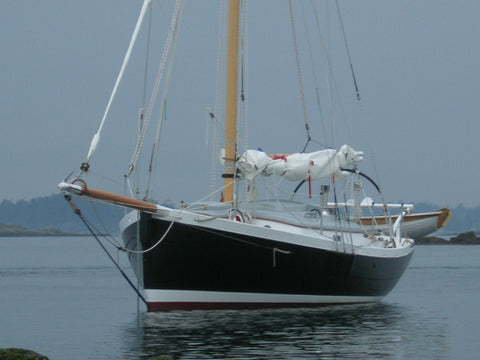This plan sheet contains the designs of two small boats intended for use as tenders for larger vessels. They are very similar in dimension and identical in construction. One is transom sterned; the other is a double-ender. One customer chose the transom sterned model so as to be able to use an outboard, and these first construction photos are of the transom sterned boat.

Here the plank rabbet is being chopped in the oak stem. This is a simple matter provided the lofting is done thoroughly, producing accurate patterns for rabbet and bearding lines. A fid the same thickness as the planking is used to check the rabbet depth.
The fit of the plank laps and the rebates at the plank ends is the test for builders of clinker boats. These are wood to wood fits with no bedding. Watertightness is determined by the ability of the wood to swell and the quality of the fit. At stem and transom the plank ends are fastened with copper nails driven into tight pilot holes and bedded on a coat of red lead paint.

In clinker work the frames usually go in after the planking is fitted and fastened. Two processes are visible here. In the foreground, light lining-out battens are tacked in place and adjusted for evenness of spacing and natural lie against the hull. When satisfactory, their positions are lightly marked with pencil and the frames are fitted in their place. A batch of frames has already been installed farther aft.

Traditionally dinghies are fitted with sprung floorboards of light material resting directly on the bent frames. They are held in place by cross strapping that tucks under the fixed centre plank, with buttons on the outer margin pieces, and can be easily removed for cleaning. The trick to making these lie properly is to steam bend the cross strapping and assemble the floorboards in place. This way the compound curve is built into them and they lie naturally in place.
Varnish finish inside and out, with a white enamel bottom make for a smart little boat. The fender is 1 in. diameter three-strand nylon glued into a coved rubrail.







